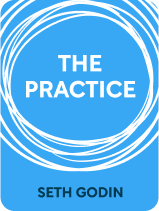

This article is an excerpt from the Shortform book guide to "The Practice" by Seth Godin. Shortform has the world's best summaries and analyses of books you should be reading.
Like this article? Sign up for a free trial here.
Where does creative inspiration come from? Does the “muse” exist?
Many artists rely on the “muse” to get inspired. In The Practice, Seth Godin says that the muse doesn’t exist, or at least shouldn’t be your main source of creative inspiration.
Keep reading to learn what can help you get inspired.
Creative Inspiration Follows Work
Creatives often speak of being “touched by the muse” or working in a state of flow. Indeed, there are times when it feels like magic infiltrates your work and genius flows through you. When you aren’t creatively inspired in this way, it can be hard to make progress, and everything you create feels flat and boring. It might seem like you only have two choices: Produce low-quality work, or give up for the day until inspiration returns.
But Godin says that letting yourself feel this way is a form of giving up your own agency. The truth is that creative inspiration shows up when you put in the work. You don’t create because you’re inspired; you’re inspired because you create. Rather than waiting for inspiration to arise or for conditions to be perfect, simply do the work to allow inspiration the opportunity to arise.
Plus, while working when you’re not inspired can be challenging, Godin points to research showing that you’re more likely to improve if a task is difficult for you. When you’re trying to get better at something, you’re necessarily going to feel incompetent before you get there. So while you’re often going to feel incompetent while you’re creating, if you don’t challenge yourself, you can’t improve.
Creativity and the Muse
Godin claims that there is no magic to the creative process. However, many artists throughout history have had inspiration occur through the muse.
The idea of muses originates in Greek mythology. Muses were the goddesses of inspiration in literature, science, and the arts. They were the nine daughters of Zeus (king of Olympian gods) and Mnemosyne, the Titan goddess of memory. (It was appropriate that the mother of the muses was Memory because, in a largely illiterate society, memory was necessary to remember the words of great artists.) Each of the muses excelled in her unique talent. For example, Calliope was the muse of epic poetry, and Thalia was the muse of comedy. The words “museum” and “music” both come from the word muse.
The muses have provided creative inspiration to poets and artists throughout history, from the ancient Greeks to Shakespeare, Milton, and beyond. Homer invokes the muse in the opening lines of some of the earliest works in Western literature, The Iliad and The Odyssey.
Contemporary artists continue to believe in the power of the muse—or a similar type of “magic.” Elizabeth Gilbert, a friend of Godin’s, strongly disagrees with his position that creativity is not magic. In her book, aptly titled Big Magic, she details her belief that creative ideas are actually a type of energetic life form moving through the air around us at all times and searching for someone who they can “speak through.” If you say “yes” to these ideas when they visit you, then much like muses, they will bless you with inspiration. Gilbert recognizes, however, that magic is not enough. Like Godin, she is a huge proponent of practice, persistence, and hard work.

———End of Preview———
Like what you just read? Read the rest of the world's best book summary and analysis of Seth Godin's "The Practice" at Shortform.
Here's what you'll find in our full The Practice summary:
- Why creativity doesn't require any “magic”
- How creativity is a skill that anybody can learn
- Step-by-step lessons on how to be creative






